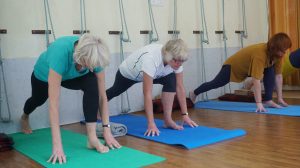Prevent Pain. Stay Strong.
You know exercise is important to your health. It helps you feel better physically, gives you energy, and helps you deal with the stress of your busy life.
But what do you do when life gets too busy to take an exercise class, go for a run, or get to the gym?
It’s easy to start skipping exercise when life gets busy, but that leads to less energy, and aches and pains cropping up. This makes you feel like exercising even less, and leads to a downward spiral. That means that finding time to exercise when life is busy is even more important.
If you can find 8 minutes, you can maintain your strength even on your busiest day.
 Exercise doesn’t have to take lots of time. In fact, your 8 minutes don’t even have to be all together. You can break them up throughout the day. Doing one exercise for one minute every hour while at work counts just as much as doing 8 minutes of exercise after the kids are in bed and before you collapse on the couch. The following exercises use your body weight for resistance, so you don’t need any equipment. They also use many muscle groups at onces so you can maintain strength in your whole body in a short amount of time.
Exercise doesn’t have to take lots of time. In fact, your 8 minutes don’t even have to be all together. You can break them up throughout the day. Doing one exercise for one minute every hour while at work counts just as much as doing 8 minutes of exercise after the kids are in bed and before you collapse on the couch. The following exercises use your body weight for resistance, so you don’t need any equipment. They also use many muscle groups at onces so you can maintain strength in your whole body in a short amount of time.
Exercises
1. The plank; Lying on your stomach, with your forearms on the ground, elbows under the shoulders, and arms parallel to the body. Toes tucked under, engage your stomach muscles and lift your body up. Hold for 20 seconds, rest 5 seconds, and repeat 3 times.
2. Push up; (do on your knees if you need an easier version). 20 seconds of push ups, 10 seconds of rest and repeat.
3. Quadruped – Start on your hands and knees with your hands under your shoulders, and you knees under your hips. Lift and reach with one arm and the opposite leg, maintaining a stable core. Hold 10 seconds and repeat on opposite side. Repeat 5 times.
4. Bridge; Lying on back, with your knees bent, engage your abdominals and lift your hips. Hold 20 seconds, rest 5 seconds, and repeat 3 times.
5. Lunge; Stand tall and take a large step forward with the right leg, shifting your weight forward. Lower your body until the right thigh is parallel to floor and your right shin is vertical. (do not let the knee shift past right toe). Return to the start and repeat on the other side. Repeat 20 times.
6. Squat to heel raise; Feet shoulder width apart, core engaged and arms raised high above the head. Perform a squat and return to standing then rise onto your toes. Repeat 20 times.
Contact In Home Therapy of Grand Rapids if you would like more information about the exercises or are in need of therapy to recover from your pain or injury.

 For people living with chronic pain, trying to find ways to manage it often becomes a daily struggle. But, focusing solely on the physical aspects of chronic pain is not going to make it dissipate because studies show that chronic pain also is caused by stress and
For people living with chronic pain, trying to find ways to manage it often becomes a daily struggle. But, focusing solely on the physical aspects of chronic pain is not going to make it dissipate because studies show that chronic pain also is caused by stress and 